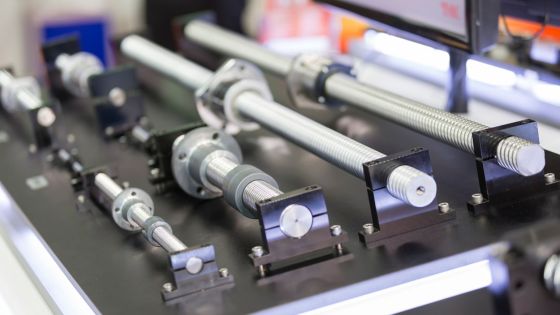Ball screws are components that serve as mechanical linear actuators in aircraft, automobiles, industrial machines, and many other applications. Most people working in these industries know that ball screws convert rotational motion to linear motion. However, few have a clear understanding of exactly how they work. This article will offer a comprehensive introduction to clear up any confusion surrounding this admittedly complex subject.


Ball Screw Basics
Ball screws feature screw shafts and nuts that contain ball bearings that roll between matching helical grooves. The helical grooves and rolling ball bearings reduce mechanical contact in the screw assembly, replacing sliding with rolling friction for more efficient power conversion.
Reducing the amount of friction generated by using ball bearings makes ball screws highly efficient at converting power. When fabricated by an expert ball screw manufacturer, these small components play a huge role in transmitting forces to either stationary or dynamic loads with high precision and repeatability.
Key Components
Now that the basic mechanisms have been made clear, let’s take a moment to look at each component of the ball screw individually. From the screw shaft to the ball bearings, each has an essential role to play.
Screw Shaft
Screw shafts receive the rotational force generated by the initial power source. That force causes the screw shaft to rotate around its axis, allowing the power to be translated into linear motion.
The most essential feature of the screw shaft is the ball groove, which runs helically around it. People sometimes refer to the screw shaft’s ball groove as the thread, and it serves as a pathway for the ball bearings.
Ball screws can have threads that are semi-circular or their ball grooves can form a gothic arc. While the former is formed by a single arc, the latter features an ogival shape consisting of two arcs. These two groove profiles feature different contact points with the ball bearings.
Each type of ball screw shaft can be defined using a set of universal specifications:
- Nominal diameter refers to the maximum diameter of the shaft without its ball bearings.
- Ball circle diameter is the center-to-center distance of two ball bearings opposite each other on the shaft while it is in operation.
- Root diameter refers to the minimum diameter of the screw shaft measured from the bottom-most section of one ball groove to its opposite groove.
- Pitch refers to the axial distance between ball grooves.
- Lead is the linear distance covered by one complete screw rotation along the axis.
- Start is the number of helices found on the screw shaft.
Nut
The ball screw’s nut houses both the ball bearing and the recirculation system. The nut features internal ball grooves that match those found on the screw shaft, and its primary purpose is to hold the balls in place.
There are two important specifications for ball nuts. The first is the number of circuits, or closed paths that form the recirculating system. The latter is the turn of the circuit, which refers to the number of times the ball travels around the screw shaft before being recirculated via deflector, return tube, or end cap to its original position.
Ball Bearings
Often referred to simply as the balls, the ball bearings are what reduce friction generated by the nut and shaft. As they move between the nut and the shaft, these steel balls form contact points distinguished by the groove profile. Without this feature, ball screws would generate too much friction to be functional in their current applications.
Factors Affecting Accuracy
Ball screws must be highly accurate and precise to be useful. In the industry, this is referred to as having a minimal lead error. This difference between actual and theoretical distances the nut travels as the screw shaft rotates is dependent on manufacturing accuracy.
To minimize lead error, manufacturers must ensure the accuracy of the ball grooves and the set-up precision of the entire assembly. Lead accuracy can be increased in three ways.
1. Preloading
Preloading places axial force on the ball bearings and ball grooves to make them more compact. This technique increases rigidity and eliminates backlash or lost motion caused by the clearance between ball bearings and thread tracks. Preloading mechanisms include:
- Spacer preloading in which a spacer is inserted to apply force on the adjacent sides of two ball nuts.
- Spring preloading, where a spring is used to apply tensional forces on two adjacent sides of the ball nuts transmitting the preload.
- Offset lead preloading in which the manufacturers create an offset in the lead with no spacers or springs required.
- Oversized ball preloading, which produces a compact structure by increasing the contact area.
2. Lubrication
Lubrication helps to prevent premature equipment failures by further lowering the friction coefficient and minimizing heat build-up. Lubricants have a cooling effect, which reduces the thermal expansion of the components caused by continuous rubbing. Lubrication also helps to prevent galling, or abrasive wear caused by microscopic tears in the metal’s surface.
3. Increased Mounting Accuracy
Mounting accuracy is crucial to lead accuracy. Without it, noise, vibration, and positioning errors can cause accelerated wear. Mounting accuracy is increased by checking auxiliary components such as nut brackets, couplings, and bearing components and correcting inaccuracies immediately.
Ball Screws Are Worth the Money
Some manufacturers initially resist incorporating ball screws into their designs because they are more expensive than lead screws. However, while lead screws may be an effective option for lower loads where accuracy and capacity aren’t important, ball screws are essential in any high-precision, high-repetition application.
Because ball screws tend to be expensive, manufacturers need to find a reliable vendor that only sells brand-name products. Look for a company that offers custom ball screw manufacturing and retrofitting or conversion services. That way, the same ball screw supplier can help industrial equipment and other manufacturers with any projects that could come up. Companies that offer custom ball screw manufacturing and retrofitting often offer repair and rebuild services that can save their clients’ money, as well, so be sure to ask if these services are available.

























